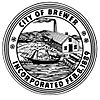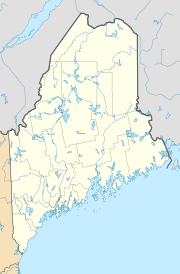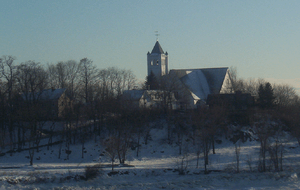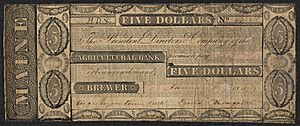Brewer, Maine facts for kids
Quick facts for kids
Brewer
|
||
|---|---|---|
|
City
|
||
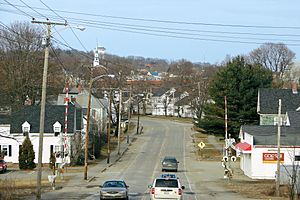 |
||
|
||
| Motto(s):
"A Community of Caring"
|
||
| Country | United States | |
| State | Maine | |
| County | Penobscot | |
| Settled | 1777 | |
| Incorporated (town) | February 22, 1812 | |
| Incorporated (city) | March 30, 1889 | |
| Government | ||
| • Type | Mayor-council government | |
| Area | ||
| • Total | 15.68 sq mi (40.62 km2) | |
| • Land | 15.24 sq mi (39.47 km2) | |
| • Water | 0.45 sq mi (1.16 km2) 2.87% | |
| Elevation | 49 ft (15 m) | |
| Population
(2020)
|
||
| • Total | 9,672 | |
| • Density | 634.73/sq mi (245.07/km2) | |
| Time zone | UTC−5 (EST) | |
| • Summer (DST) | UTC−4 (EDT) | |
| ZIP Code |
04412
|
|
| Area code(s) | 207 | |
| FIPS code | 23-06925 | |
| GNIS feature ID | 0562936 | |
| Website | www.brewermaine.gov | |
Brewer is a city in Penobscot County, Maine, United States. It is part of the Bangor metropolitan area. The city is named after its first settler, Colonel John Brewer. In 2020, about 9,672 people lived there.
Brewer is like a twin city to Bangor. They are located on opposite sides of the Penobscot River and are connected by three bridges. Long ago, both Brewer and Bangor were part of a larger area called Condeskeag Plantation. Brewer was also known as "New Worcester." In 1788, Brewer became part of the town of Orrington, Maine. Later, in 1812, Brewer became its own separate town. It officially became a city in 1889.
Contents
Geography and Climate
Brewer covers about 15.68 square miles (40.62 square kilometers). Most of this area is land, with a small part being water. The city includes smaller areas called South Brewer and North Brewer. South Brewer used to be a big industrial area.
Climate in Brewer
Brewer has a climate with big changes in temperature throughout the year. Summers are warm, sometimes hot and humid. Winters are cold, and can be very cold. This type of weather is called a humid continental climate.
Education
- Brewer Community School
Historic Buildings
Brewer has some interesting old buildings. One is the Daniel Sargent House in South Brewer. It was built in 1847 and is listed on the National Register of Historic Places. Daniel Sargent owned a large sawmill. He was also a military leader during the American Civil War.
The city's most famous building is the First Congregational Church. It sits on a hill overlooking the river and Bangor. It has a unique architectural style called "shingle style."
Historic Industries
Brewer was once very famous for making bricks. In the 1850s, there were many brickyards. They made millions of bricks each year. Most of these bricks were sent to Boston. Many buildings in Boston's Back Bay and South End neighborhoods were built with Brewer bricks.
Ship-building was also a big industry in Brewer. So was saw-milling, which means cutting wood into lumber. Brewer's sawmills often used steam power. In the late 1800s and early 1900s, the city also had a large ice industry. The Getchell Brothers company still continues this tradition today.
The Eastern Manufacturing Company opened a paper mill in South Brewer in 1889. It became the city's biggest employer. The mill closed in 2004. This company was known for making high-quality paper, like their "Atlantic Bond" brand.
Notable Events
In 1900, a 17-year-old girl named Dione Polliot became famous. She won $10 (which was a lot of money back then) for climbing to the top of the Eastern Manufacturing Company's 173-foot chimney! The company had offered money to the first boy who could do it, but no one had succeeded. Dione took the challenge and won.
In 1903, a group of people broke into the Brewer Savings Bank. They used dynamite to get into the vault. They took some money and then escaped across the bridge to Bangor. The police tried to catch them, but they got away.
A sad event happened in 1906. Four students from Brewer High School drowned while sailing on Brewer Lake. Graduation ceremonies were canceled that year. Many people attended their funeral.
Notable People
Many interesting people have come from Brewer:
- Gen. John Blake – An army officer who led soldiers in the War of 1812.
- Maj. Gen. Joshua Chamberlain – A Civil War hero and a former Governor of Maine.
- Sean Danielsen – The lead singer and guitarist for the band Smile Empty Soul.
- Howie Day – A singer and musician who grew up in Brewer.
- Charles Fletcher Dole – An important Unitarian minister and writer.
- Fannie Hardy Eckstorm – An author and expert on birds and local folklore.
- Oliver C. Farrington – A famous geologist and expert on meteorites.
- Stephanie Lynne Niznik – An American actress.
- William E. Quinby – An editor and a United States Ambassador to the Netherlands.
Population Information
| Historical population | |||
|---|---|---|---|
| Census | Pop. | %± | |
| 1820 | 744 | — | |
| 1830 | 1,078 | 44.9% | |
| 1840 | 1,736 | 61.0% | |
| 1850 | 2,628 | 51.4% | |
| 1860 | 2,835 | 7.9% | |
| 1870 | 3,214 | 13.4% | |
| 1880 | 3,170 | −1.4% | |
| 1890 | 4,193 | 32.3% | |
| 1900 | 4,835 | 15.3% | |
| 1910 | 5,667 | 17.2% | |
| 1920 | 6,064 | 7.0% | |
| 1930 | 6,329 | 4.4% | |
| 1940 | 6,510 | 2.9% | |
| 1950 | 6,862 | 5.4% | |
| 1960 | 9,009 | 31.3% | |
| 1970 | 9,300 | 3.2% | |
| 1980 | 9,017 | −3.0% | |
| 1990 | 9,021 | 0.0% | |
| 2000 | 8,987 | −0.4% | |
| 2010 | 9,482 | 5.5% | |
| 2020 | 9,672 | 2.0% | |
| sources: | |||
In 2010, Brewer had 9,482 people living there. The average age of people in Brewer was about 41 years old. About 20% of the residents were under 18 years old.
Images for kids
See also
 In Spanish: Brewer (Maine) para niños
In Spanish: Brewer (Maine) para niños


